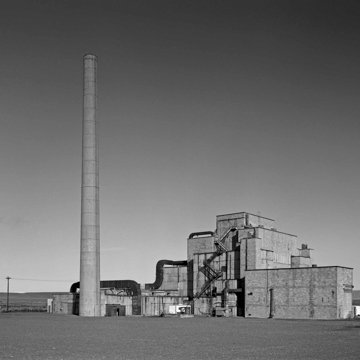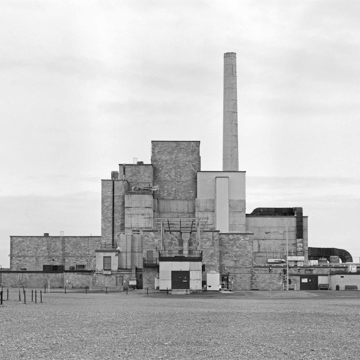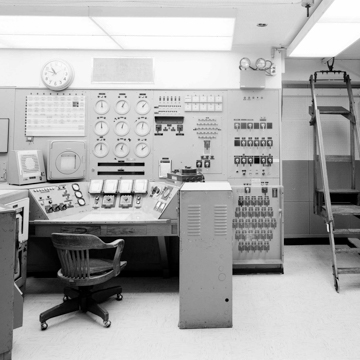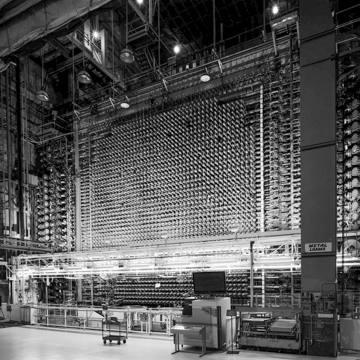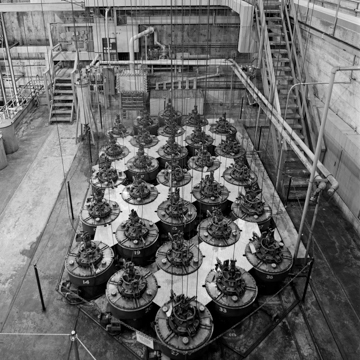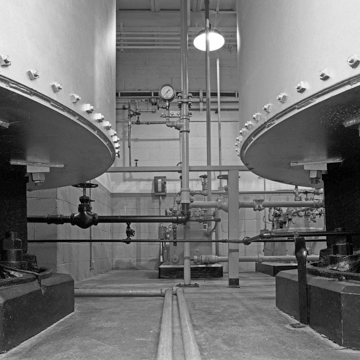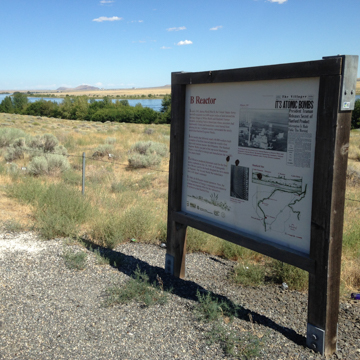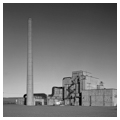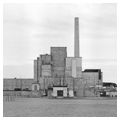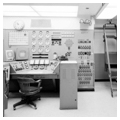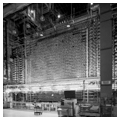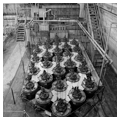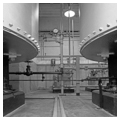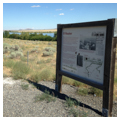You are here
B Reactor
The Hanford B Reactor was the world’s first large-scale nuclear reactor. During World War II, workers at the reactor (code-named 105-B), produced plutonium for the Trinity Nuclear Test in Los Alamos, New Mexico, and the “Fat Man” bomb dropped over Nagasaki, Japan. The building, located in the northwest corner of a massive site near State Route 240 in the remote high desert area of southeastern Washington, was commissioned as part of the nation’s top-secret “Manhattan Project,” which involved research into, and development of, the world’s first atomic bombs. The project was the catalyst for the permanent transformation of the landscape of what is now known as Washington’s “Tri-Cities” area, which includes the cities of Richland, Kennewick, and Pasco.
For thousands of years, Wanapum Indians fished along the banks of the Columbia River and considered sacred many of the surrounding geographical features. By the late 1800s, the first white settlers began to arrive, many by rail, and established the present-day communities of Kennewick and Pasco. By the turn of the twentieth century, Seattle-based land development companies funded an irrigation project to provide a steady supply of water to the region. This drew another wave of settlement to the new towns of Hanford, Richland, and White Bluffs. Initial agricultural development and town growth were hampered—but not dashed—by the Great Depression, and by the end of the 1930s the many acres of orchards, strawberries, alfalfa, and asparagus were highly productive. The surrounding communities were small, but thriving. The agricultural landscape changed dramatically in 1943, when existing property owners and farmers were required to vacate the land for the war effort. Soon, plutonium factories and hundreds of support buildings were set up in the Hanford and White Bluffs area and a new population of 50,000 transformed the region forever.
The Manhattan Project marshaled the industrial and scientific resources of a wartime United States, with support from the United Kingdom and Canada, to produce the world’s first atomic weapons. In all, the project comprised more than thirty sites across the United States, including an enriched uranium reactor in Oak Ridge, Tennessee, and a research and design laboratory in Los Alamos, New Mexico. Major General Leslie Groves led the two-year project, which included the construction of the plutonium production and refining facilities and the B Reactor, which was essentially a scaled-up version of Enrico Fermi’s Chicago Pile-1—the experimental nuclear reactor built in 1942 underneath squash courts at the University of Chicago. The B Reactor was designed and built by the Du Pont Corporation under a war contract with the United States Army, and all other plutonium-producing reactors built in the United States, until the 1963 completion of the N Reactor at Hanford (which also provided electricity), are based upon the same essential design. The B Reactor is the last surviving building from the original development in Washington, known as the “Hanford Engineering Works.”
The exterior of the B Reactor is composed of various types of concrete (including cast-in-place concrete and concrete masonry), while the interior contained water-processing facilities, a fuel element cooling bay, a control room, and the massive water-cooled graphite block reactor known as the “pile.” This reactor dominated the interior: a 28 x 36–foot box weighing over 1,200 tons and penetrated by 2004 aluminum tubes carrying uranium fuel slugs. Channels for safety rods, inserted to shut down the reaction if necessary, penetrated the reactor vertically. The precise operations of the B Reactor were achieved without any existing precedents in design or engineering.
The reactor included a pump house to divert water from the nearby Columbia River, water storage and settling basins, a filtration plant, large motor-driven pumps for delivering water, and facilities for emergency cooling in the event of a power failure. The river was a crucial resource and much of the infrastructure at Hanford revolved around pumping, storing, and cooling the spent water used in the reactors. Each reactor also had a separate coal-fired power plant and water towers to keep it running in emergency situations. Both the reactor and uranium fuel slugs were water-cooled before they were sent to the Chemical Separations Plant (or T-Plant).
The loss of a constant flow of water could cause disaster. Engineers calculated that even a one-minute interruption of a continuous flow of water at a rate of about 75,000 gallons per minute would cause the graphite block to overheat, expand, and crack, releasing lethal radiation into the atmosphere. Should the reaction require emergency stoppage, horizontal control rods, which could be pulled out to increase the chain reaction, were designed also to be pushed into the graphite block, slowing or halting that reaction. Further safety measures, including the dropping of vertical safety rods and the pouring of liquid boron, were designed into the reactor in the event that the horizontal control rods did not perform their intended function. The reactor, which required a crew of about twenty people to operate, nonetheless functioned without any major incident during its active lifespan. It was deactivated in 1968.
Following deactivation, General Electric (the government contractor then running the Hanford Engineering Works) and, later, the U.S. Department of Energy (DOE) began admitting select groups for reactor tours. In 1992, the B Reactor was added to the National Register of Historic Places and in August 2008, the Department of the Interior designated it a National Historic Landmark. In 2015, an agreement between the DOE and the National Park Service established the Manhattan Project National Historical Park which comprises the Hanford Site, Oak Ridge, and Los Alamos. The Hanford site remains among the government’s active “Superfund” cleanup sites.
References
Findlay, John M., and Bruce Hevly. Atomic Frontier Days: Hanford and the American West. Seattle: University of Washington Press, 2011.
Chatters, J. C., “Hanford B Reactor,” Benton County, Washington. National Register of Historic Places Inventory-Nomination Form, 1989. National Park Service, U.S. Department of the Interior, Washington, D.C.
Sanger, S. L. Working on the Bomb: An Oral History of WWII Hanford. Portland, OR: Continuing Education Press, 1995.
Writing Credits
If SAH Archipedia has been useful to you, please consider supporting it.
SAH Archipedia tells the story of the United States through its buildings, landscapes, and cities. This freely available resource empowers the public with authoritative knowledge that deepens their understanding and appreciation of the built environment. But the Society of Architectural Historians, which created SAH Archipedia with University of Virginia Press, needs your support to maintain the high-caliber research, writing, photography, cartography, editing, design, and programming that make SAH Archipedia a trusted online resource available to all who value the history of place, heritage tourism, and learning.

